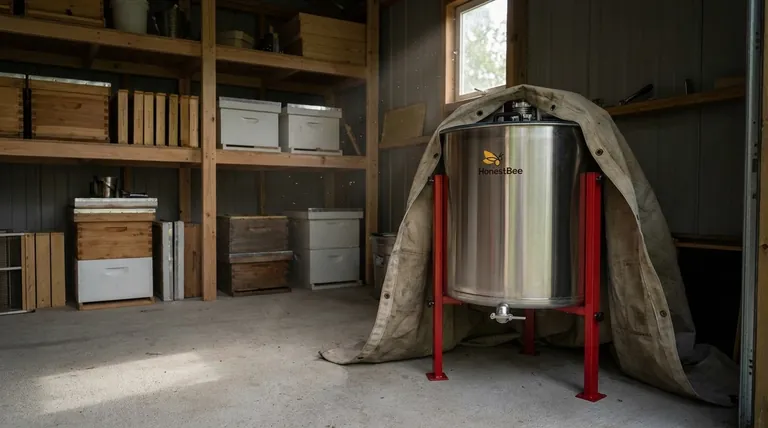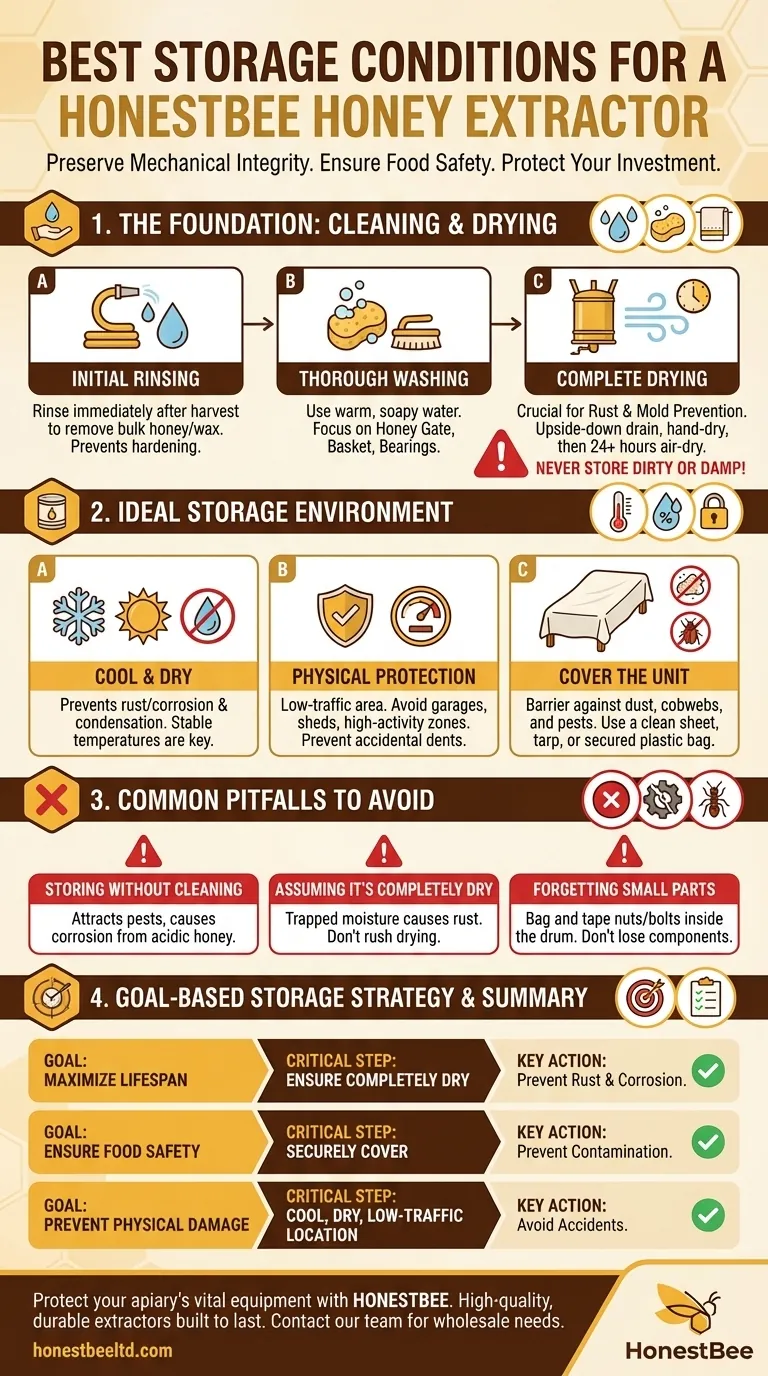To properly store a honey extractor, you must place it in a cool, dry location where it will not be accidentally damaged. After thoroughly cleaning and drying the machine, covering it with a sheet or plastic is essential to protect it from dust, debris, and pests during the off-season.
The goal of storage is not just to put the extractor away, but to preserve its mechanical integrity and ensure it remains food-safe for the next harvest. This requires a focus on three key elements: cleanliness, environmental control, and physical protection.

The Foundation of Proper Storage: Cleaning
Before considering where to store your extractor, you must prepare it. Storing a dirty extractor is the single biggest mistake you can make, as it invites pests and corrosion.
Step 1: Initial Rinsing
Immediately after extraction, rinse the extractor with warm water to remove the bulk of the remaining honey and wax. This prevents the honey from hardening, which makes later cleaning much more difficult.
Step 2: Thorough Washing
Use a soft cloth or sponge with warm, soapy water to clean all interior and exterior surfaces. Pay special attention to the honey gate, basket, and any bearings, as these are critical components.
Step 3: Complete Drying
Drying is the most critical step for preventing rust and mold. After the final rinse, turn the extractor upside down to drain completely. Hand-dry all accessible surfaces with a clean towel and then allow it to air-dry for at least 24 hours to ensure no moisture remains.
Selecting the Ideal Storage Environment
Once your extractor is perfectly clean and dry, the location you choose will determine its condition next season.
Why 'Cool and Dry' is Non-Negotiable
A dry environment is paramount for preventing rust and corrosion, especially on any non-stainless steel parts like gears or leg bolts. Cool, stable temperatures prevent any condensation that can form when temperatures fluctuate.
The Importance of Physical Protection
Storing the extractor away from high-traffic areas in a garage, shed, or basement is crucial. A simple bump can dent the drum or damage the spinning mechanism, leading to costly repairs.
Covering the Extractor
A cover acts as a barrier against dust, cobwebs, and insects. A simple bedsheet, tarp, or large plastic bag secured around the unit is sufficient to keep the interior clean and ready for use.
Common Pitfalls to Avoid
Proper storage is as much about avoiding mistakes as it is about following the right steps.
Storing Without Cleaning
Residual honey will attract ants, mice, and other pests. The acidic nature of honey can also contribute to the corrosion of metal parts over time if left sitting.
Assuming It's Completely Dry
Trapped moisture is the primary cause of rust. Never rush the drying process. Ensure every crevice, especially around the honey gate and bearings, is bone-dry before you cover and store the unit.
Forgetting Small Parts
If you disassemble your extractor for cleaning (e.g., removing the legs or honey gate), place all nuts, bolts, and small components in a sealed bag and tape it securely to the inside of the extractor drum.
Making the Right Choice for Your Goal
Your storage strategy should align with your primary objective for the equipment.
- If your primary focus is maximizing equipment lifespan: Ensure the extractor is immaculately clean and, most importantly, completely dry to prevent any chance of rust or corrosion.
- If your primary focus is food safety for next season: Pay close attention to securely covering the extractor to prevent any dust, debris, or pests from contaminating the food-contact surfaces.
- If your primary focus is preventing physical damage: Choose a low-traffic corner or dedicated space where the extractor will not be bumped, knocked over, or used as a shelf.
Properly preparing and storing your honey extractor is the final, critical step in your beekeeping season, ensuring your investment is protected and ready for the next harvest.
Summary Table:
| Goal | Key Action | Critical Step |
|---|---|---|
| Maximize Lifespan | Prevent Rust & Corrosion | Ensure the extractor is completely dry before storage. |
| Ensure Food Safety | Prevent Contamination | Securely cover the unit to block dust, debris, and pests. |
| Prevent Physical Damage | Avoid Accidents | Store in a cool, dry, low-traffic location. |
Protect your apiary's vital equipment with HONESTBEE.
Proper storage starts with a high-quality, durable honey extractor. As a trusted wholesale supplier to commercial apiaries and beekeeping equipment distributors, we provide the robust equipment built to last season after season.
Let us help you safeguard your investment and ensure operational readiness for every harvest. Contact our team today to discuss your wholesale needs and discover the HONESTBEE difference.
Visual Guide

Related Products
- Electric 8 Frame Honey Spinner Extractor Equipment for Beekeeping
- HONESTBEE 72 Frame Industrial Electric Honey Extractor for Beekeeping
- HONESTBEE 3-Frame Manual Acrylic Honey Extractor
- 2 Frame Stainless Steel Manual Honey Spinner Extractor for Beekeeping
- 8-Frame Electric Self-Reversing Honey Extractor Spinner for Commercial Honey Extraction Equipment
People Also Ask
- What is an extractor in beekeeping? Unlock Sustainable Honey Harvesting
- What should be considered when harvesting honey from multiple hives? Scale Your Harvest Efficiently
- What are the differences between manual and electric honey extractors? A Beekeeper's Guide to Power, Speed & Cost
- How long should you spin honey? Master the Art of Efficient, Damage-Free Extraction
- What equipment is needed for extracting honey? A Complete Guide for Every Beekeeper



















